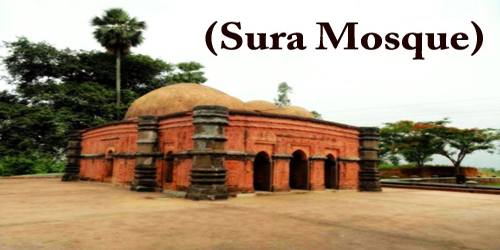The Sura Mosque (Bengali: সূরা মসজিদ) is a sixteenth-century mosque, situated in Sura, under Ghoraghat Upazila, in the district of Dinajpur, Bangladesh, about 11 kilometers west of the Ghoraghat ruins, and about 6 kilometers in the same direction from the Ghoraghat Upazila headquarters. There is no inscription tablet at the mosque, but it was dated to the early sixteenth century in the light of its close ties with similar-style dated monuments. An inscription from the time of Alauddin Hussain Shah, dated at 910 A. H./1504 A. D. was discovered in the village Champatali, a few miles away from the place. It records the development of a mosque, and if this inscription describes the mosque at Sura, the year 1504 A. D. is that the date of its construction. Bricks and stones were used for its construction. An honest number of stone slabs lie all around the mosque. Some stone slabs contain panels and other designs just like those at the ‘Chhota Sona Mosque’. In addition, the decorations on the outer surface of the walls were rendered with terracotta ornamentation that depicted the conventionalized chain and bell motif. Had the wall been faced with stone, it would have been difficult to incorporate terracotta ornamentation in brick into the walls.
Sura Mosque is a single domed, square mosque facing a verandah. The mosque sits on an elevated mound of earth, and a flight of steps approaches from the South. It has a 4.87 m square prayer chamber flanked on the east by a 1.82 m wide foreroom and measures externally 8.53 m by 12.50 m. It was once surrounded by high walls which in Bengal is a design otherwise unknown. On all four sides of the mosque, the open terrace was secluded by massive surrounding walls, which are now at the plinth level. To the east, there are three arched entrances, and north and south, each one. There are three decorated mihrabs on the western wall. The hall is roofed by a hemispherical dome, carried on squinches, and supported by pillars. Three domes cover the verandah of the mosque and therefore the phase of transition is within the pendentive system. These domes have a close affinity with the domes of the ‘Chhota Sona Mosque’. The wall of the kiblah comprises three semicircular mihrab niches with cusped arches, each set within a rectangular ornamented framework. The main mihrab is one of the three, the largest, and is of stone. The brick walls are faced with a stone slab from within and therefore the outside surfaces have some evidence of rich carving work of terracotta.
















